“Our space capabilities will be contested,” declared Gen. C. Robert Kehler, head of Air Force Space Command. “We have seen evidence [of the danger] from a number of places around the world.”
USAF’s senior space officer may have been matter-of-fact in his delivery, but his message was as serious as a stroke. He had just summarized a mortal challenge to the US—the growing threats to America’s traditional dominance of the military high ground.
Once, such dangers were theoretical. No longer.
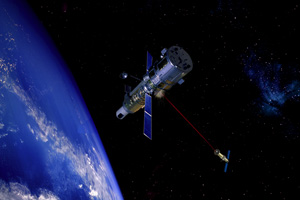 |
An artist’s conception of a space based laser weapon. (Illustration by Erik Simonsen) |
Space isn’t a lonely place anymore. It is a crowded commons that attracts the attention of many national and commercial space actors. The list includes, but is not limited to, Russia, China, India, and a unified Europe, not to mention a host of medium-size nations.
Operating in this busy domain depends on a suite of capabilities, from launch facilities to communications links and robust spacecraft.
As the Air Force looks to the future, it is finding that the best assurance of continued space dominance is strong situational awareness in the vast reaches above the atmosphere.
This means knowing who is doing what to whom or has put itself in a position to take action of some sort. And as space becomes more and more contested, the act of sorting and tracking the activity “up there” is key to delivering space and missile capabilities to America and its military commands.
“We must increase our awareness of what is going on on orbit,” Kehler said.
Case in point: China’s Jan. 11, 2007 successful test of an anti-satellite weapon against one of its own spacecraft took this nation’s space-watchers by surprise. The Chinese launched a medium-range ballistic missile with a kinetic kill vehicle, which homed in on and destroyed a defunct Feng Yun 1C polar orbiting meteorological satellite. (China’s geographic location prevents it from launching satellites against low-inclination, equatorial orbits.) The solid-fuel, mobile ASAT missile came from or near the Xichang Space Center and hit the satellite at an altitude of more than 530 miles. On impact, the satellite disintegrated into more than 900 pieces of orbital debris. The Chinese did not announce the event at the time.
Australian strategic affairs analyst Desmond Ball said the Chinese ASAT launch “involved a fairly primitive system” but one that threatened to spark a space race. Ball added: “It is the sort of capability available to any country with a store of … medium-range/intercontinental ballistic missiles or satellite launch vehicles, and a long-range radar system.” These nations, said Ball, include Japan, India, Pakistan, Iran, and even North Korea.
China Is Getting Serious
In the view of a White House spokesman, China’s test was “inconsistent with the spirit of cooperation that both countries aspire to in the civil space area.”
“This is bad news,” said Peter Brookes of the Heritage Foundation, a US think tank. He warned, “China is on a trajectory to challenge Washington (and Moscow) for pre-eminence in space.”
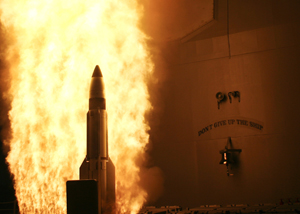 |
A missile aboard USS Lake Erie blasts off to intercept and destroy a nonfunctioning NRO satellite on Feb. 20. (USN/DOD photo) |
There’s no question that China is serious about space. Chinese taikonauts traveled there in 2003 and 2005, and according to Brookes, Beijing plans to put a man on the Moon sometime after 2010. China will launch perhaps 100 satellites in the next five to eight years, Brookes wrote in “China’s Space-Attack Test,” a Heritage Foundation background paper.
How is the Air Force dealing with this new challenger? According to Kehler, the Chinese anti-satellite launch “was not a surprise … [but] it added a sense of urgency.”
Key elements of US space policy date back to the space race of the 1960s and its immediate aftermath. It was an era when the Soviet Union was testing numerous anti-satellite systems. Nuclear weapons in space were a real possibility.
Ultimately, the superpowers cooled their competition. The Outer Space Treaty of 1967 outlawed nuclear or other weapons of mass destruction in space, in orbit, or on the Moon. It also put the Moon and other celestial bodies off-limits for weapons testing, fortifications, or military maneuvers.
The 1972 Anti-Ballistic Missile Treaty placed further limits on exo-atmospheric interceptor deployments. The net effect was to put the brakes on development of space weapons and preserve a relatively tranquil domain.
Despite this, dangers remained. Numerous experiments involving ground-based sites and on-orbit tracking and intercepts kept the theories and technologies percolating. The ABM Treaty was modified several times to clarify what was permitted and how to handle borderline cases.
In its first 50 years, however, the routine use of space was undisturbed and relatively unquestioned.
Ironically, it was a threat to ground stations and communications links that foreshadowed the new era of concern. The Sept. 11, 2001 terrorist attacks in America warned AFSPC to the fact that physical infrastructure on the ground was susceptible to asymmetric attack. Space Command quickly began improvements in the physical security and redundancy of ground sites. An office for integrated space situational awareness was set up in 2002.
Still, those were relatively “low-key” changes that did not set off alarms.
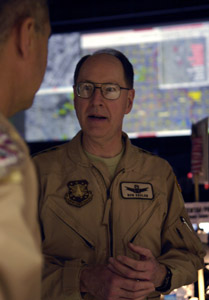 |
The head of Air Force Space Command, Gen. Robert Kehler (right), takes a briefing at the 609th Air Operations Center in Southwest Asia. Kehler says America’s space capabilities will be contested. (USAF photo by SSgt. Christina M. Styer) |
China’s 2007 action did. It raised multiple concerns about protecting satellites on orbit and about tracking and dealing with both operational satellites and with debris and unintended consequences.
By then, space had gone from being a playground of the two superpowers to being a global commons.
During the Cold War, the number of space-faring nations was “single digit,” said Lt. Gen. Michael A. Hamel, who is commander of USAF’s Space and Missile Systems Center at Los Angeles AFB, Calif. Currently, 30 or 40 countries operate in space—and all expect to see more.
That’s created a major shift in priorities. No longer can Air Force Space Command simply watch out for what Moscow is doing. AFSPC now wrestles with keeping track of multiple users. Unfortunately, the elaborate architecture built to keep an eye on the Soviet Union’s space and missile activities was not designed for the 21st century space environment.
“During the Cold War, we had a very, very significant investment in sensor systems, in command and control centers, to be able to keep track of what the Soviet Union was doing in space,” noted Hamel.
“Our space surveillance network was largely built during the Cold War, for the Cold War,” said Kehler. “Quite honestly, we have some coverage gaps,” he acknowledged. Add to that the shortfalls in the fidelity of sensor coverage and “fixing, upgrading, [and] updating space situational awareness is important,” he said.
A Massive Job
Job one is improving the combination of sensors, data links, and analytic fusion needed to build awareness. Think of this critical area as akin to building a common operational picture or air battlespace picture. No air operations center commander would attempt to run day-to-day operations without it. Yet the space picture is much less complete.
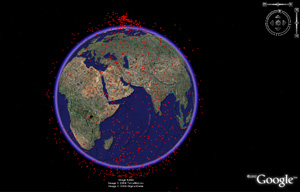 |
This screenshot, captured from a modified Google Earth program, depicts the debris field left when China destroyed a polar orbiting meteorological satellite with a medium-range ballistic missile. (Debris data visualization by Robert J. Simpson, orbitingfrog.com) |
“Even though space is a big place, the fact is that you do need to exercise some measure of monitoring of what is actually going on,” said Hamel.
Keeping track of what objects in orbit are doing is a massive job and the core of a critical mission area called space situational awareness.
Space situational awareness includes both space environment conditions and the actions of all nations in space. It “means having knowledge about all the objects in orbit, what are they doing, both friendly as well as hostile systems,” said Hamel.
Space “weather” such as radiation from solar flares is one part of the environment. Another is monitoring man-made and other objects in rotational belts.
“We’re tracking upwards of 15,000 detectable objects in space right now,” said Hamel, “to ensure that we avoid collision and other kinds of hazards.”
Those are just the “big” objects measuring 10 centimeters (four inches) or more. Many smaller objects exist in space.
Certain zones are crowded. The geostationary orbit at 90 degrees east is one case in point. “That’s over the central part of Asia, and guess what? There are a lot of satellites that want to operate there,” observed Hamel.
Radio frequency interference is an issue. Individual operators maneuver their satellites to keep position. Air Force space professionals have to monitor those movements to make sure they don’t threaten operations.
Only recently has the Air Force started to increase its capability to survey large volumes of space. Just as important is moving away from the tight focus on Russian space assets.
“A lot of what we’re doing now is taking many of the systems that were built for one purpose, [such as] dealing with a missile warning against a potential Soviet attack, … and trying to knit [them] together in a way in which we can really draw upon all kinds of sensing phenomena, whether that be radar systems [or] optical trackers,” explained Hamel. The goal is to “put it into really a modern net-centric architecture so that we’re able to provide much more rapid, current knowledge of all the objects in space.”
Two approaches will help. One is a new program for space-based situational awareness. Packages of optical sensors will fly on satellites and enhance tracking abilities. First launch of this system is planned for 2009.
Second, space professionals plan to take advantage of heavy traffic in the geostationary orbits to fly payloads to assist with tracking. As Hamel described it, location is everything. Plans are under way to “ride-share or piggyback sensors on a variety of satellites, both military as well as possibly even commercial systems.” These can provide a sort of “neighborhood watch program,” tracking nearby objects and warning of close approaches before collision occurs.
It will take all that and more to assure the environmental conditions are conducive to on-orbit operations.
“I’m not a big fan of creating space debris,” said USAF Gen. Kevin P. Chilton, commander of US Strategic Command. “I’ve been on the space shuttle. I’ve had orbital debris hit my vehicle,” he said.
The ideal, in Chilton’s view, is to monitor satellites heading to space even before they launch. “When it gets on orbit, we track it from the boost phase all the way to on-orbit,” he said. Then “if it maneuvers, we know it maneuvers, and we find that out in a very timely fashion, rather than in a long period of time where you risk losing track of it.”
It would be “a whole lot easier” if other nations and commercial entities would “share with us their knowledge of where their satellites are,” Hamel said. The final dimension is intent. Knowing the intentions of the government or group launching the satellite would be equally important, said Chilton.
Until then, it will be up to radar and optical trackers to maintain the mosaic.
Sensors aren’t the only part of the equation. Space situational awareness is seen by all top commanders as the absolute precondition for taking any action in space, be that defensive or offensive.
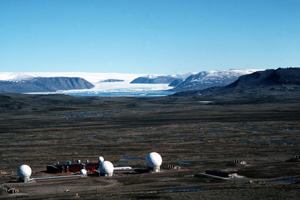 |
Radar domes, contributors to space situational awareness, dot the tundra at Thule AB, Greenland, home to USAF’s 3rd Detachment, 3rd Space Support Wing. (USAF photo) |
High-Quality Situational Awareness
A case in point was the destruction of a US satellite on Feb. 20, 2008. Although the classified reconnaissance satellite had only been on orbit since December 2006, it malfunctioned and was in danger of soon tumbling out of orbit. This was unacceptable, as the satellite—and its toxic hydrazine fuel supply—could have survived re-entry and crashed into a populated area. The LEO satellite was therefore destroyed by a Navy SM-3 launched from the cruiser USS Lake Erie on station in the Pacific Ocean.
“The prime lesson I took away from the missile defense activity that was used against the US satellite was the value of high-quality, high-confidence space situational awareness,” said Kehler.
Officials stress that space situation awareness requires better fusion of existing data. Integrated space situational awareness is about “how … we net together … many of the sensor systems that we already have, to make them much more efficient and responsive,” said Hamel.
Fusing intelligence into an operational picture is what provides the real value. As Chilton put it, the overall tasks of “how you handle the data and fuse it and present it to commanders and refresh that data … are really important.”
Kehler said finding ways to use sensors “more effectively is at the top of our list and has gotten increased investment here over this last year or so.” He has told Congress that it’s not a huge number of dollars in the budget, but it’s a top priority because of the payoff.
For example, the February US missile defense shot had to link existing sensors in a different way. To Kehler, that showed that with the right fusion “there is an opportunity here for high-value, high-confidence space surveillance” with platforms already on duty.
He stressed that the satellite shootdown was not a precursor to developing new ASAT weapons.
“Our US policy says be prepared. It doesn’t say go [and] do,” Kehler cautioned. The US is “not pursuing an active anti-satellite weapon at this point in time. What you saw was a one-time use of missile defense assets in a very carefully controlled manner. … We always have an option to go down that road in the future, but at this point in time, we are not actively pursuing that kind of an activity.”
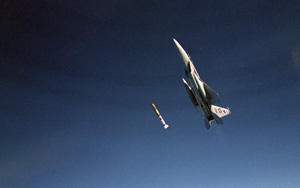 |
An F-15 releases an anti-satellite missile during a test. (DOD photo) |
Detering Signal Jamming
For now, improving awareness and securing communications links remain more fruitful investment areas.
Space Command is taking steps to deter and resist jamming, for example. Jamming the Global Positioning System is “not a hard thing to do,” said Kehler. “That technology is out there.”
Russia is a known purveyor of GPS jamming technology, for example.
So far, GPS jamming has been a spectacular failure. Saddam Hussein tried to jam GPS signals at the beginning of Operation Iraqi Freedom in 2003. The Russian-made jammers were obliterated by air attack within two days.
Future measures include boosting the power of the GPS signal and engineering new satellites for greater protection.
Laser obfuscation of satellite sensors has long been a concern and remains so today. “We’ve seen others developing laser dazzlers against some of our surveillance and reconnaissance sensors,” Kehler said.
Beyond this, Space Command is acutely aware that its dominance goes hand-in-hand with freedom of action in cyberspace.
“There is clearly a very real cyberspace threat,” pointed out Kehler. The synergy of space and cyberspace goes back decades because space platforms have long operated both in space and cyberspace. Input controls and data output all depend on communications links between satellites, ground stations, and command centers.
Operators literally fly satellites based on those links. In contrast with the world of manned aircraft, space operations have been dependent on cyberspace. A pilot can maneuver an aircraft mechanically or electronically; maneuvering a satellite relies on remotely transmitted commands.
In fact, the close links between space and cyberspace put a lot of punch in the Air Force’s cross-domain mission statement. “You can see physical boundaries in the air and … in space,” explained Kehler. “We don’t see a separation of space and cyberspace” because of the way the platforms have to be integrated, he added.
While space links are some of the most secure and protected communications on the planet, the potential vulnerability is serious. As Kehler said, “It’s important for us to understand that cyberspace can be used against us also. The Army has a wonderful saying, … ‘If the enemy’s in range, so are you.’ “
Kehler stressed, “It may be that the biggest cyberspace threat that we face in our space business is on the ground and in the ground sites.”
One area where AFSPC seems sure of dominance is in keeping the lead in space capabilities for the nation.
Space—and improving space situational awareness—is on the table in Congress’ latest effort to review service roles and missions.
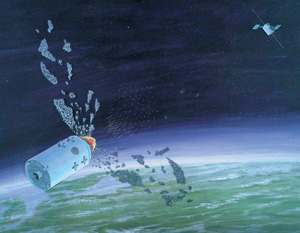 |
At right, an artist’s conception of a Soviet-era orbital satellite attacking a space target. |
Top leaders say space roles and missions issues amongst the services are more perception than reality. Hamel was unambiguous on this point. In “every interaction I have had … there is absolute, unequivocal, steadfast support from both the Army, the Marine Corps or Navy, in terms of their dependence upon future space capabilities, whether that be communications, data systems, GPS, surveillance reconnaissance systems.”
The simple fact is that Air Force space capabilities far outdistance those of any other service. USAF performs the bulk of the mission for the Defense Department. “Upwards of almost 90 percent of the resources and activities that are done by the department are done by the US Air Force,” Kehler said.
“It’s a mission that the United States Air Force has had for almost 50 years,” he added. “I personally don’t see a major change.”
To no one’s surprise, the bigger questions may lie in the interagency arena. As Kehler acknowledged, “There does remain a question here about the relationship between the space activities that are conducted by the Intelligence Community and the space activities that are conducted by the Department of Defense.”
On the bright side, Kehler believes “we have better cooperation today in many areas than we have had … in the past.”
That’s good news. Just as achieving air dominance was the central mission of 20th century airpower, securing space dominance is just as vital to operations in the 21st century.
| How to Attack a Satellite
The US, the Soviet Union-Russia, and China have all studied or demonstrated techniques for attacking satellites. Some are kinetic kills and others use nuclear bursts, radio frequencies, or lasers to disable satellites. Many of the techniques have been around since the 1960s and 1970s. Surface-launched missiles: As China did in 2007 and the US did in 2008, hitting a satellite with a missile is the best-known method of attack. Low Earth orbit (LEO) satellites are vulnerable, but geostationary satellites currently are not because their GEO orbits keep them out of range. Location matters: Weapons launched from China, for example, probably could not reach low-inclination equatorial orbits. Most vulnerable are polar-orbiting satellites with perigees that bring them well within range of surface-based tracking radars and missiles. Nuclear missiles: Among the many ASAT techniques developed by the Soviet Union was the Galosh deployed around Moscow in the late 1960s. The exo-atmospheric ballistic missile carried an estimated three-megaton nuclear warhead capable of obliterating LEO satellites passing over Moscow. The follow-on Gorgon system with a one-megaton warhead is still operational. Air-launched missiles: In September 1985, the US fired a three-stage Air Launched Miniature Vehicle from a specially modified F-15 and destroyed an old satellite. Congress banned ALMV testing three months later. Co-orbital systems: In this variation, a missile is launched to the target satellite’s orbital plane, and its warhead is steered to impact within one or two orbits. Reports indicate that co-orbital systems can also deploy parasitic micro-satellites kept in position to destroy or disable the target satellite on command. The Soviet Union first tested co-orbital systems in the late 1960s. Space-based interceptors: Numerous experiments have demonstrated the feasibility of hitting a satellite with another satellite, and study work is ongoing. Lasers: “Painting” satellites with laser beams and the temporary blinding of their optical sensors has been going on since the mid-1970s. Reports claim the Soviet Union painted infrared detection sensors on a US Defense Support Program satellite in 1975 and may even have painted the space shuttle. US activities ranged from alleged temporary blinding of Soviet satellites to full tests against US satellites. DOD has warned since 1998 that China has a capability to conduct laser blinding. Radio frequency: Radio frequency weapons jam satellite signals. |
Rebecca Grant is a contributing editor of Air Force Magazine. She is president of IRIS Independent Research in Washington, D.C., and has worked for RAND, the Secretary of the Air Force, and the Chief of Staff of the Air Force. Grant is a fellow of the Eaker Institute for Aerospace Concepts, the public policy and research arm of the Air Force Association. Her most recent article, “Toward the Totally Educated Airman,” appeared in the April issue.